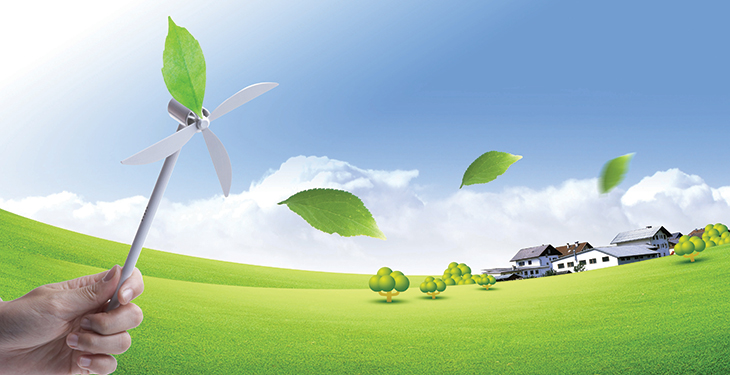After the first historical stage of collective efforts towards decarbonization and diversification of the energy mix, Romania is one of the countries that has reached its proposed target of 24% for 2020, reaching, according to public data, a share of 24,5% of green energy in 2017, including the production capacities of the hydropower system. For the future, the vision of the Energy Strategy of Romania 2019-2030 with the prospect of the year 2050 foresees an increase of the Romanian energy sector by building new capacities of energy production, but also the re-technologization and modernization of the production capacities, energy transport and distribution, simultaneously with the encouragement of increasing domestic consumption under conditions of energy efficiency.
European ambitions
At European level, the climate change and the decarbonization target are the central elements, together with the efforts to create an interconnected, competitive market, which now brings to the fore a new active player – the consumer. In June 2019, Directive (EU) 2019/944 on the common rules for the internal market of electricity, amending Directive 2012/27 / EU, as well as Regulation 943/2019 on the internal market of electricity, both responding to the challenges and needs imposed by the common market, which is undergoing a major transformation process. Renewable energy continues to play a key role, so a comprehensive legal framework sets specific rules for certain types of renewable energy production facilities, energy storage and dispatching and balancing rules for the transportation system.
Local potential
Beyond Romania’s confirmed potential in terms of availability of green technology-friendly locations, investors’ appetite and decisions depend on a stable, predictable, competitive regulatory framework and similar taxation procedures. After several years of a significant decrease in investments, the last year has brought some important changes in the legislative plan, which could bring a new breath to the entire electricity market. Some of these legislative changes seek to improve or rectify practical situations related to the functioning of the green certificates market, or are meant to create new investment opportunities for the future, a more flexible regulatory framework and more favorable to financing large projects.
Green certificates
For example, Law 184 / 2018 – passed on July 23, 2018 introduced the „prosumer” definition.
Another important aspect of the law is a set of measures regarding the treatment and marketing of green certificates. This means that all green certificates (CVs) issued between 1 April 2017 and 31 December 2031, including deferred CVs from trading, are guaranteed if the final consumption does not fall below the average value established for the period 2017 – 2022. Electricity producers and public authorities holding electricity production capacities of up to 3MW – that benefit from or have benefited from the support scheme and hold the CV – can conclude directly negotiated contracts only with the suppliers for the sale of electricity and / or CVs (by way of derogation from Art. 23 of the Electricity and Natural Gas Law).
From 1 April until 31 December 2020, producers with production capacity for solar energy accredited by ANRE up to 31 December 2013 will be temporarily suspended from trading two CVs for every 1MWh produced and delivered. The CVs can be recovered starting from 1 January 2021, in monthly instalments until 31 December 2030. The quantity of electricity subject to the obligation to purchase the CVs includes electricity produced in Romania and sold by the suppliers to consumers or suppliers outside Romania, through bilateral electricity transactions, in the countries with which the Romanian government has signed bilateral agreements.

New support schemes for green energy
The Ministry of Energy, together with the National Energy Regulatory Authority, is developing a new scheme designed to support the production of clean energy in the form of a fixed price for the type of technology, which is added to the average price of electricity resulting from transactions on the centralized electricity markets.
In addition, to address the issues related to the extended wear and tear of existing capacities, to help transition to clean energy and to balance the new mix generated by an increasing share of renewable energy sources, authorities are considering the introduction of a support scheme to help the investments in new low-carbon electricity generation capacities.
Contracts for difference
The new proposed scheme is inspired by the British system of CfD (contracts for difference) covering both sectors, renewables and nuclear, and “clean” technologies. Through this mechanism, eligible producers may enter into a private law contract (CfD contract) with the nominated counterparty and agree on a “strike price”.
Producers sell electricity on the competitive market; but if the market price (reflected in the so-called “reference price”) falls below the strike price, the counterparty will reimburse producers the difference. Likewise, if the market price exceeds the strike price, the producers will reimburse the difference to the counterparty.
Completion of the legal framework is long awaited, as the first stage undertaken by the Ministry has seen long debates with the business community which is keen to see: a clear perspective for future possible investments; the priorities of the Romanian state regarding a long-term assurance of the sustainable energy mix and market development in trend with international technologies and practice. Long-term recovery investments in electricity generation require financial instruments that may support financing of the magnitude required by the profile of these projects.
Bilateral contracts
Regulation 943/2019 on the electricity internal market will enter into force from 1 January 2020 and has immediate application in all European Union countries.
Although art. 23 of Law 123/2012 (which prohibits bilateral contracts) is not in accordance with Regulation 943/2019, by adopting the European regulation the green wave will be given to the bilateral contracts for the sale and purchase of electricity. Such contracts, prohibited until now, would allow new renewable investors to take loans from banks, by providing long-term sources of income. In this regard, a draft amendment to Law 123/2012 is currently in the Chamber of Deputies and an amendment is expected to reintroduce bilateral contracts. This draft law currently provides among other changes and the possibility of investors from energy projects to trade the energy expected to be produced by the new production capacities, before they are authorized by ANRE and put into operation. The intention of the legislator and the regulator is to be welcomed, as this change would remove one of the biggest barriers so far for new investors to enter the market, which will provide the possibility to conclude long-term contracts for future production, through which they ensure a predictable revenue stream and can therefore attract external funding sources.
New market tools
Moreover, the Bucharest Stock Exchange (BVB) and OPCOM have started the establishment of a Central Counterparty which completely eliminates the risk of a characteristic counterparty of the two markets and creates the premises for launching “futures” type contracts, having as active support the electricity. It is expected that this project will be finalized and operational by 2020, which would be a remarkable progress in diversifying the products through which the energy market can finance, especially in the long term, and will provide investors, especially the financial ones, sophisticated trading variants.
Finally, returning to a fully liberalized market is one of the major desires of any investor, in line with European policies and EU countries’ practice. It is configured “a secondary market deal flow” – a wave of sales of the operational plants built over the last 10 years, which confirms a degree of confidence of the new investors taking over existing operations in the Romanian market.
—————————————-
This article firstly appeared in the printed edition of energynomics.ro Magazine, issued in December 2019.
In order to receive the printed or electronic this issue of energynomics.ro Magazine, we encourage you to write us at office [at] energynomics.ro to include you in our distribution list. All previous editions are available HERE.


